群体智能优化算法及其在光谱变量选择中的研究进展
Progress of swarm intelligent optimization algorithm methods and researches in spectral variable selection
杨文博,汪若馨,张容玲,刘鹏,卞希慧
天津工业大学化学工程与技术学院,中国天津,300387
摘要:群体智能(Swarm Intelligence,SI)优化算法模拟生物群体的智慧而具有强大的搜索能力,在函数求解、参数选择、多目标优化等方面引起了广泛关注。近年来,群体智能优化算法也成为光谱分析领域的研究热点。本文首先总结了已提出的102种群体智能优化算法的基本信息,并从三个角度对这些算法进行分类。然后整理了应用于光谱量选择的群体智能优化算法,探讨了群体智能优化算法在变量选择方面的相同点和不同点,包括实现过程、适应度函数、位置更新和离散化。最后,讨论了群体智能算法选择光谱变量面临的挑战和未来前景,为其他群体智能优化算法的引入以及新型群体智能优化算法的提出提供参考。
关键词:元启发式算法;群体智能优化算法;光谱分析;变量选择
1. 引言
由于简单、快速、无损等优势,光谱分析结合化学计量学在农业、食品、制药、化工、石油、烟草、环境等领域得到了广泛应用[1-6]。然而,光谱数据往往包含成千上百个变量,并不是所有变量都与分析目标相关。变量选择方法可以去除这些无关变量,降低数据维度,提高化学计量学模型的建模效率和预测性能。因此,变量选择是光谱建模前的一个重要步骤。
变量选择是一个典型的NP优化难题[7],随着变量数的增多,采用排列组合去寻找最优变量组合会逐渐变成一个不可能完成的任务。许多变量选择方法被提出,如连续投影算法(Successive Projections Algorithm,SPA)[8]、变量投影重要性(Variable Importance in Projection,VIP)[9]、无信息变量消除算法(Uninformative Variable Elimination,UVE)[10]、蒙特卡罗-无信息变量消除法(Monte Carlo-UVE,MC-UVE)[11]、随机检验(Randomization Test,RT)[12]、竞争性自适应重加权采样(Competitive Adaptive Reweighted Sampling,CARS)[13]、迭代保留信息变量法(Iteratively Retains Informative Variables,IRIV)[14]和元启发式算法[15]等。术语“元启发式”指“更高层次的启发式算法”,是“元”和“启发式”的组合,其中“元”指超越或更高层次,“启发式”指通过试错找到或发现目标。历史上,具有随机机制的方法经常被称为“启发式算法”。元启发式算法[16-18]通常作为“主策略”发挥作用,受到遗传、群体行为和进化等自然现象的启发,指导并修改其他启发式算法,以找到问题的最优解或者接近最优解的解,在计算机科学、数学优化和工程领域得到了广泛应用[19]。到目前为止,已经提出和研究了大量的元启发式算法。包含群体智能优化算法、进化算法、物理化学算法和基于人类的算法[20-25],如图1所示。
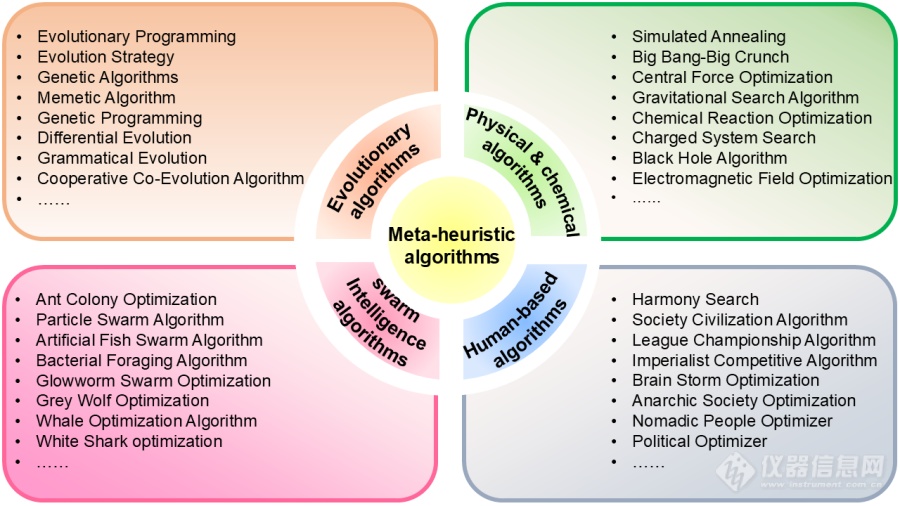
图1 元启发式优化算法的分类
生物群体通过个体之间的分工、协同合作等,可以比单一个体更高效地完成觅食、繁殖和迁徙等行为。群体智能优化算法[26]是一种通过模拟自然界中生物群体某个或某些行为来建立数学模型,从而解决各种复杂的优化问题的方法。群体智能优化算法的核心思想是利用多个生物个体之间的相互作用和信息交换,实现全局搜索,得到全局最优。到目前为止,已经开发了一百多种群体智能优化算法,并在多个领域取得了显著进展,包括光谱分析[27]、代谢组学和蛋白质组学的质谱分析[28,29]以及定量构效关系(Quantitative Structure-Activity Relationship, QSAR)[30]。这些算法在解决变量选择[31]、参数优化[32]及图像处理[33]等组合优化问题方面发挥了重要作用。然而,至今尚无文献对这些群体智能优化算法进行系统性的总结。
本文综述了102种群体智能优化算法的统计信息,并根据生物类别、算法模拟的生物行为以及算法机理三个角度进行分类。同时,论述了不同群体智能优化算法应用于光谱变量选择的相同点和不同点,并对其面临的困难和未来的展望进行讨论。
2. 群体智能优化算法
2.1 现有群体智能优化算法的统计信息
群体智能优化算法模拟自然界中群体的集体行为。这些群体包括鸟类、鱼类、昆虫、动物、植物、微生物等。在群体智能中,每个个体都有其独特的智慧与行为,算法中个体的组合能为解决复杂优化问题提供更大的力量[23,36]。从1991年到2024年,提出了一百多种群体智能优化算法。每年提出算法的数目如图2(a)所示。群体智能优化算法的发展可以分为三个阶段。第一阶段从1991年到2002年,为算法发展的初期,在这期间只提出了两种算法。第二阶段从2002年到2013年,在这期间每年都有新算法提出,可看作算法的探索阶段,然而后来几年相比,发展速度相对较慢。相比之下,2014年至2024年的第三阶段恰逢人们对计算机科学的兴趣激增和计算机科学的进步,导致提出的算法数量迅速增加。这一阶段的显著特点是其积极的增长轨迹,尤其是在2021年,提出的群体智能优化算法数量最多。
此外,图2(b)显示了不同国家对群体智能优化算法的贡献情况。由图可知,来自19个国家的研究人员提出了102种算法。在这些国家中,只有4个国家贡献了5种以上的算法。其中,中国的研究人员提出的算法数量最多,共有31种。继中国之后,伊朗的研究人员提出了15种算法。此外,来自印度和澳大利亚的学者分别提出了11个和7个算法。这一分布彰显了中国在推进群体智能优化算法领域的突出作用。在算法的发展长河中,国内外不少学者对算法的提出不断做出贡献,图2(c)显示了提出两个及以上算法的作者。其中,共有16位学者提出了两种或两种以上的算法,Mirjalili是群体智能优化算法领域的知名专家,不仅提出了7种算法,而且参与了其他几种算法的合著。其次是Dhiman和Yang,提出了4种算法。Braik和Naruei提出了3种算法。表1总结了102种群体智能优化算法具体的提出年份、国家、第一作者和引用次数等,未提供代码的算法在表1中使用红色标出。可以看出,缺乏公开代码的算法使用率较低,这表明提供代码可以有效促进这些算法的传播和应用。这一趋势凸显了开源代码在提高优化算法的影响力和可用性方面的重要性。
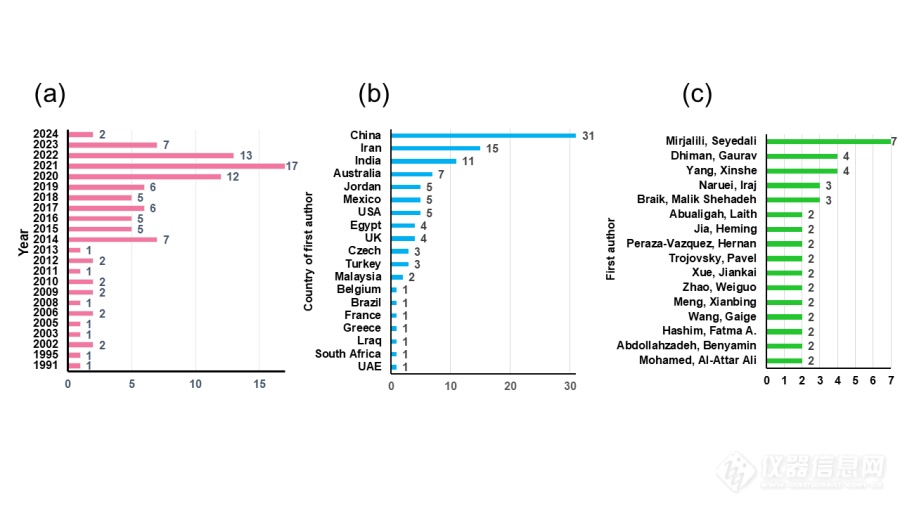
图2 102种群体智能优化算法的统计数据;(a)1991年至2024年间每年的群体智能算法数量;(b)不同国家的群体智能优化算法数量比较;(c)提出两种或两种以上群体智能优化算法的作者比较
表1 1991-2024年7月提出的群智能优化算法汇总
年份 |
中文名称 |
英文全称 |
缩写 |
第一作者 |
国家 |
被引
次数 |
1991 |
蚁群算法 |
Ant Colony
Optimization |
ACO |
Dorigo M |
Belgium |
17643 |
1995 |
粒子群优化算法 |
Particle Swarm
Optimization |
PSO |
Eberhart R |
America |
21863 |
2002 |
人工鱼群算法 |
Artificial Fish
Swarm Algorithm |
AFSA |
Li XL |
China |
1160 |
2002 |
细菌觅食优化算法 |
Bacterial Foraging Optimization Algorithm |
BFOA |
Passino K M |
America |
4022 |
2003 |
混合蛙跳算法 |
Shuffled Frog
Leaping Algorithm |
SFLA |
Eusuff M M |
America |
2074 |
2005 |
人工蜂群算法 |
Artificial Bee
Colony Algorithm |
ABC |
Karaboga D |
Turkey |
8685 |
2006 |
猫群算法 |
Cat Swarm
Optimization |
CSO |
Chu SC |
China |
516 |
2006 |
入侵杂草优化算法 |
Invasive Weed
Optimization |
IWO |
Mehrabian A R |
Iran |
1733 |
2008 |
猴群算法 |
Monkey Algorithm |
MA |
Zhao RQ |
China |
257 |
2009 |
布谷鸟搜索算法 |
Cuckoo Search
Algorithm |
CS |
Yang XS |
England |
8757 |
2009 |
萤火虫优化算法 |
Firefly Algorithm |
FA |
Yang XS |
England |
5472 |
2010 |
蝙蝠算法 |
Bat Algorithm |
BA |
Yang XS |
England |
6506 |
2010 |
蟑螂群优化算法 |
Cockroach Swarm
Optimization |
CoSO |
Chen ZH |
China |
61 |
2011 |
果蝇优化算法 |
Fruit Fly
Optimization Algorithm |
FOA |
Pan WT |
China |
1890 |
2012 |
花朵授粉算法 |
Flower Pollination Algorithm |
FPA |
Yang XS |
England |
2787 |
2012 |
磷虾群算法 |
Krill Herd
Algorithm |
KHA |
Gandomi A H |
America |
2119 |
2013 |
群居蜘蛛优化算法 |
Social Spider
Optimization |
SSO |
Cuevas E |
Mexico |
650 |
2014 |
动物迁徙优化算法 |
Animal Migration Optimization |
AMO |
Li XT |
China |
317 |
2014 |
鸡群优化算法 |
Chicken Swarm
Optimization |
ChSO |
Meng XB |
China |
739 |
2014 |
蝉鸣优化算法 |
Cicada Sing
Optimization |
CiSO |
He YC |
China |
2 |
2014 |
灰狼优化算法 |
Grey Wolf
Optimization |
GWO |
Mirjalili S |
Australia |
15654 |
2014 |
鸽群优化算法 |
Pigeon-Inspired Optimization |
PIO |
Duan HB |
China |
386 |
2014 |
蜘蛛猴优化算法 |
Spider Monkey
Optimization |
SMO |
Bansal J C |
India |
608 |
2014 |
共生生物搜索算法 |
Symbiotic Organisms Search |
SOS |
Cheng MY |
China |
1591 |
2015 |
蚁狮优化算法 |
Ant Lion
Optimization |
ALO |
Mirjalili S |
Australia |
3204 |
2015 |
鸟群算法 |
Bird Swarm
Algorithm |
BSA |
Meng XB |
China |
486 |
2015 |
帝王蝶优化算法 |
Monarch Butterfly Optimization |
MBO |
Wang GG |
China |
79 |
2015 |
飞蛾扑火优化算法 |
Moth-Flame Optimization |
MFO |
Mirjalili S |
Australia |
4089 |
2015 |
树种优化算法 |
Tree-Seed Algorithm |
TSA |
Kiran M S |
Turkey |
331 |
2016 |
乌鸦搜索算法 |
Crow Search
Algorithm |
CSA |
Askarzadeh A |
Iran |
2144 |
2016 |
蜻蜓优化算法 |
Dragonfly Algorithm |
DA |
Mirjalili S |
Australia |
2673 |
2016 |
象群优化算法 |
Elephant Herding
Optimization |
EHO |
Wang GG |
China |
340 |
2016 |
蛾群算法 |
Moth Swarm
Algorithm |
MSA |
Mohamed A A A |
Egypt |
499 |
2016 |
鲸鱼优化算法 |
Whale
Optimization Algorithm |
WOA |
Mirjalili S |
Australia |
11092 |
2017 |
天牛须搜索算法 |
Beetle Antennae
Search Algorithm |
BAS |
Jiang XY |
China |
2 |
2017 |
蚱蜢优化算法 |
Grasshopper Optimization Algorithm |
GOA |
Mirjalili S |
Australia |
2584 |
2017 |
樽海鞘优化算法 |
Salp Swarm
Algorithm |
SSA |
Mirjalili S |
Australia |
4324 |
2017 |
缎蓝园丁鸟优化算法 |
Satin Bowerbird
Optimizer |
SBO |
Moosavi S H S |
Iran |
284 |
2017 |
自私羊群优化算法 |
Selfish Herds
Optimization |
SHO |
Fausto F |
Mexico |
164 |
2017 |
斑鬣狗优化算法 |
Spotted Hyena
Optimizer |
SpHO |
Dhiman G |
India |
948 |
2018 |
郊狼优化算法 |
Coyote Optimization Algorithm |
COA |
Pierezan J |
Brazil |
549 |
2018 |
鹰栖息优化算法 |
Eagle Perching
Optimizer |
EPO |
Khan A T |
China |
23 |
2018 |
狮群优化算法 |
Lion Swarm
Optimization |
LSO |
Liu SJ |
China |
22 |
2018 |
松鼠搜索算法 |
Squirrel Search
Algorithm |
SqSA |
Jain M |
India |
833 |
2018 |
绯鲵鲣优化算法 |
Yellow Saddle
Goatfish Algorithm |
YSGA |
Zaldivar D |
Mexico |
70 |
2019 |
蝴蝶优化算法 |
Butterfly Optimization Algorithm |
BOA |
Arora S |
India |
1360 |
2019 |
哈里斯鹰优化算法 |
Harris Hawks
Optimization |
HHO |
Heidari A A |
Iran |
4409 |
2019 |
蝠鲼觅食优化算法 |
Manta Ray
Foraging Optimization |
MRFO |
Zhao WG |
China |
786 |
2019 |
旗鱼优化算法 |
Sailedfish Optimizer |
SFO |
Shadravan S |
Iran |
507 |
2019 |
海鸥优化算法 |
Seagull Optimization Algorithm |
SOA |
Dhiman G |
India |
967 |
2019 |
乌燕鸥优化算法 |
Sooty Tern
Optimization Algorithm |
STOA |
Dhiman G |
India |
420 |
2020 |
秃鹰搜索算法 |
Bald Eagle Search |
BES |
Alsattar H A |
Malaysia |
487 |
2020 |
黑寡妇优化算法 |
Black Widow
Optimization |
BWO |
Hayyolalam V |
Iran |
649 |
2020 |
边境牧羊犬优化算法 |
Border Collie
Optimization |
BCO |
Dutta T |
India |
73 |
2020 |
黑猩猩优化算法 |
Chimp Optimization Algorithm |
ChOA |
Khishe M |
Iran |
866 |
2020 |
水母搜索算法 |
Jellyfish Search
Optimizer |
JSO |
Chou JS |
China |
489 |
2020 |
海洋捕食者算法 |
Marine Predators Algorithm |
MPA |
Faramarzi A |
America |
1691 |
2020 |
蜉蝣算法 |
Mayfly Algorithm |
MaA |
Zervoudakis K |
Greece |
556 |
2020 |
寄生捕食算法 |
Parasitism-Predation Algorithm |
PPA |
Mohamed A A A |
Egypt |
63 |
2020 |
黏菌算法 |
Slime Mould
Algorithm |
SMA |
Li SM |
China |
2218 |
2020 |
麻雀搜索算法 |
Sparrow Search
Algorithm |
SpSA |
Xue JK |
China |
2275 |
2020 |
囊状虫群算法 |
Tunicate Swarm
Algorithm |
TuSA |
Kaur S |
India |
991 |
2021 |
非洲秃鹫优化算法 |
African Vultures
Optimization Algorithm |
AVOA |
Abdollahzadeh B |
Iran |
844 |
2021 |
天鹰优化算法 |
Aquila Optimizer |
AO |
Abualigah L |
Jordan |
1586 |
2021 |
人工大猩猩部队优化算法 |
Artificial Gorilla
Troops Optimizer |
GTO |
Abdollahzadeh B |
Iran |
643 |
2021 |
人工蜂鸟算法 |
Artificial Hummingbird Algorithm |
AHA |
Zhao WG |
China |
523 |
2021 |
卷尾猴搜索算法 |
Capuchin Search
Algorithm |
CapSA |
Braik, M S |
Jordan |
168 |
2021 |
食肉植物算法 |
Carnivorous Plant
Algorithm |
CPA |
Pauline O |
Malaysia |
94 |
2021 |
变色龙群算法 |
Chameleon Swarm Algorithm |
ChSA |
Braik M S |
Jordan |
305 |
2021 |
白骨顶鸡优化算法 |
Coot Optimization Algorithm |
COOT |
Naruei I |
Iran |
280 |
2021 |
野狗优化算法 |
Dingo Optimization Algorithm |
DOA |
Peraza-Vazquez H |
Mexico |
117 |
2021 |
金鹰优化算法 |
Golden Eagle
Optimizer |
GEO |
Mohammadi-Balani A |
Iran |
303 |
2021 |
蜜獾优化算法 |
Honey Badger
Algorithm |
HBA |
Hashim F A |
Egypt |
735 |
2021 |
饥饿游戏搜索算法 |
Hunger Games
Search |
HGS |
Yang YT |
China |
836 |
2021 |
跳蛛优化算法 |
Jumping Spider
Optimization Algorithm |
JSOA |
Peraza-Vazquez H |
Mexico |
40 |
2021 |
鼠群优化算法 |
Rat Swarm
Optimization |
RSO |
Dhiman G |
India |
342 |
2021 |
鮣鱼优化算法 |
Remora Optimization Algorithm |
ROA |
Jia HM |
China |
239 |
2021 |
爬行动物搜索算法 |
Reptile Search
Algorithm |
RSA |
Abualigah L |
Jordan |
931 |
2021 |
金枪鱼群优化算法 |
Tuna Swarm
Optimization |
TSO |
Xie L |
China |
197 |
2021 |
野马优化算法 |
Wild Horse
Optimizer |
WHO |
Naruei I |
Iran |
300 |
2022 |
人工兔优化算法 |
Artificial Rabbits
Optimization |
ARO |
Wang LY |
China |
332 |
2022 |
白鲸优化算法 |
Beluga Whale
Optimization |
BeWO |
Zhong CT |
China |
296 |
2022 |
蜣螂优化算法 |
Dung Beetle
Optimizer |
DBO |
Xue JK |
China |
385 |
2022 |
侏儒猫鼬优化算法 |
Dwarf Mongoose
Optimization |
DMO |
Agushaka J O |
Africa |
566 |
2022 |
金豺优化算法 |
Golden Jackal
Optimization |
GJO |
Chopra N |
India |
355 |
2022 |
猎食者优化算法 |
Hunter–Prey Optimization |
HPO |
Naruei I |
Iran |
149 |
2022 |
狐猴优化算法 |
Lemurs Optimizer |
LO |
Abasi A K |
United Arab Emirates |
29 |
2022 |
北方苍鹰优化算法 |
Northern Goshawk Optimization |
NGO |
Dehghani M |
Czech |
256 |
2022 |
孔雀优化算法 |
Peafowl Optimization Algorithm |
POA |
Wang JB |
China |
25 |
2022 |
鹈鹕优化算法 |
Pelican Optimization Algorithm |
PeOA |
Trojovsky P |
Czech |
434 |
2022 |
蛇优化算法 |
Snake Optimizer |
SO |
Hashim F A |
Egypt |
539 |
2022 |
白鲨优化算法 |
White Shark
Optimizer |
WSO |
Braik M S |
Jordan |
339 |
2023 |
小龙虾优化算法 |
Crayfish Optimization Algorithm |
CrOA |
Jia HM |
China |
84 |
2023 |
狐狸优化算法 |
Fox Optimizer |
FOX |
Mohammed H |
Lraq |
72 |
2023 |
成吉思汗鲨鱼优化算法 |
Genghis Khan
Shark Optimizer |
GKSO |
Hu G |
China |
82 |
2023 |
星鸦优化算法 |
Nutcracker Optimization Algorithm |
NOA |
Abdel-Basset M |
Egypt |
104 |
2023 |
红尾鹰算法 |
Red-Tailed Hawk
Algorithm |
RTH |
Ferahtia S |
France |
19 |
2023 |
沙猫群优化算法 |
Sand Cat Swarm
Optimization |
SCSO |
Seyyedabbasi A |
Turkey |
262 |
2023 |
霸王龙优化算法 |
Tyrannosaurus Optimization Algorithm |
TROA |
Sahu V S D M |
India |
6 |
2023 |
海象优化算法 |
Walrus Optimization Algorithm |
WaOA |
Trojovsky P |
Czech |
46 |
2024 |
鳑鮍鱼优化算法 |
Bitterling Fish
Optimization Algorithm |
BFO |
Zareian L |
Iran |
0 |
2024 |
鹦鹉优化算法 |
Parrot Optimizer |
PO |
Lian JB |
China |
35 |
2.2 现有群体智能优化算法的分类
群体智能优化算法的提出通常由三个主要部分组成。第一部分是从生物学中汲取灵感。第二部分包括根据观察到的生物行为开发机制和数学模型,以及提供算法的伪代码。最后,通过基准测试函数对所提算法的性能进行了评估。因此,可以根据生物学原理对算法进行分类。
2.2.1 群体智能优化算法的生物学分类
群体智能优化算法受群居生物的启发,模拟生物的社会行为,基于生物种群划分出102种群体智能算法。算法的生物分类如图3(a)所示,这些生物分为动物、植物和微生物。基于植物的算法包括入侵杂草优化算法(Invasive Weed Optimization,IWO)、花朵授粉算法(Flower Pollination Algorithm,FPA)、树种优化算法(Tree-Seed Optimizer Algorithm,TSA)和食肉植物算法(Carnivorous Plant Algorithm,CPA)。基于微生物的算法有细菌觅食优化算法(Bacterial Foraging Optimization Algorithm,BFOA)和黏菌算法(Slime Mould Algorithm,SMA)。除了上述算法外,其余96种算法都是基于动物的。动物可以分为无脊椎动物和脊索动物,其中无脊椎动物的种类占动物的95%。然而,在目前提出的群体智能算法中,基于无脊椎动物的算法远远少于基于脊索动物的算法。除了受到腔肠动物启发的人工水母优化算法外,其他基于无脊椎动物的算法主要是模拟节肢动物。节肢动物包括昆虫纲、甲壳纲、蛛形纲和多足动物,其中以昆虫为基础的算法最为普遍。目前,还没有针对原生动物、扁形动物、线形动物、环节动物、软体动物和棘皮动物的群体智能优化算法。因此,研究这些类别的无脊椎动物并建立相应的模型来解决优化问题,可以为该领域的研究和创新开拓新思路。对于脊索动物来说,由于哺乳动物的行为多种多样,鸟类的飞行方式也多种多样,因此大量的群体智能优化算法倾向于模拟哺乳动物和鸟类。在基于脊椎动物的群体智能优化算法中,有29种算法的灵感来自哺乳动物,25种算法的灵感来自鸟类。相比之下,从其他类型动物中衍生出的群体智能优化算法相对较少,如图3(b)所示。基于动物分类的具体算法如图4所示。

图3 群体智能优化算法分类统计;(a)基于生物分类;(b)基于动物分类;(c)基于生物行为分类
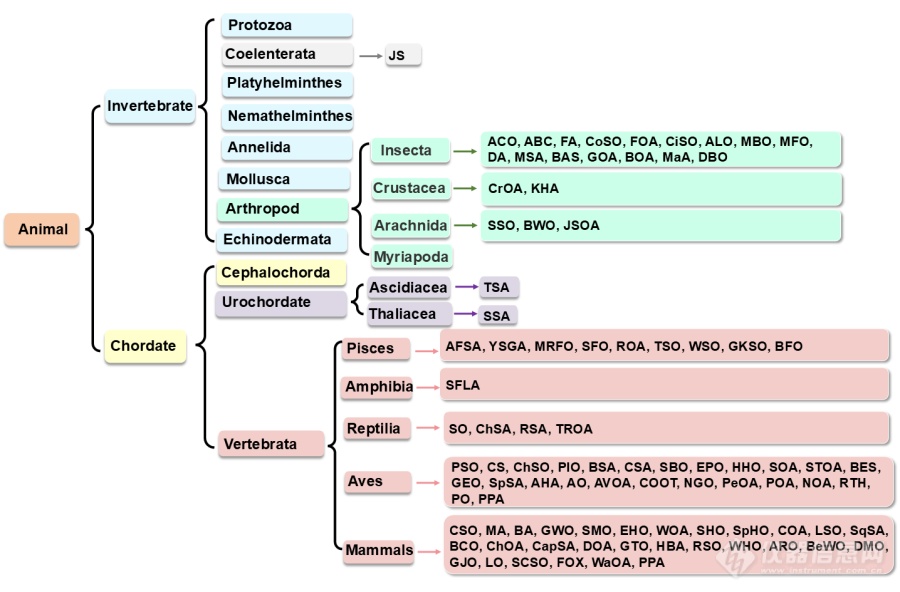
图4 基于动物分类的特殊群体智能优化算法
大自然是群体智能优化算法的灵感来源。动物有许多行为,包括进食、攻击、防御、繁殖、迁徙等。对蚁群的社会行为进行了研究,提出了基于蚁群觅食行为的蚁群算法(Ant Colony Optimization,ACO)。随着对各种动物行为研究的深入,越来越多的群体智能优化算法被开发出来。这些算法有效地模拟了觅食、繁殖、生活习性、迁徙和群居行为等基本行为。例如,?人工蜂群算法(Artificial Bee Colony,ABC)模拟蜜蜂寻找花蜜和采蜜的行为。鲸鱼优化算法(Whale Optimization Algorithm,WOA)模拟鲸鱼在水中觅食时的两种不同动作。蜉蝣算法(Mayfly Algorithm,MA)模拟雄性蜉蝣翩翩起舞,吸引雌性蜉蝣与其交配并繁殖后代。鸽群优化算法(Pigeon-inspired Optimization,PIO)通过使用磁感应在鸽子大脑中绘制地图和地标方法来模拟鸽群迁徙的行为。猫群优化算法(Cat Swarm Optimization,CSO)模拟猫环顾四周的习惯和跟踪行为。边境牧羊犬优化算法(Border Collie Optimization,BCO)模拟了边境牧羊犬群监督羊群的放牧行为。觅食是生物最基本的行为,基于觅食的群体智能优化算法占这些算法的67%。随后,基于繁殖的算法占总数的17%,反映了交配策略在群体智能技术发展中的重要性。此外,与生活方式、迁移和放牧相关的行为,算法所占比例较小,分别为7%、6%和3%。如图3(c)所示,这种分布凸显了觅食行为对算法设计的广泛影响,同时也表明了进一步探索其他可能产生创新群体智能优化算法的生物行为的潜力。对动物行为的不断探索不仅丰富了对群体智能的理解,而且有助于群体智能优化算法的发展,使算法越来越高效,并能够适应各种应用领域中的复杂优化挑战。
3. 基于群体智能优化的光谱变量选择方法
3.1 用于光谱变量选择的群体智能优化算法
光谱变量的选择可以看作是寻找使模型预测性能最佳的变量组合的过程。尽管已有102种群体智能优化算法被提出,但目前只有22种群体智能优化算法被用于光谱变量选择。表2列出了这22种算法所应用的光谱和领域。在这些算法中,蚁群算法(ACO)和粒子群算法(Particle Swarm Optimization,PSO)在求解不同光谱的变量选择问题中应用最为广泛。从表中可以看出,这些算法应用的光谱有近红外光谱、可见近红外光谱、紫外光谱、高光谱和拉曼光谱等,主要应用于近红外光谱和可见近红外光谱。在应用领域方面,这些算法主要用于食品和环境领域。通过对这22种用于解决光谱变量选择问题的群体智能优化算法的研究,总结了这些算法在光谱变量选择方面的相同点和不同点。图5展示了用于光谱变量选择的群体智能优化算法的常见流程。每种群体智能算法都必须遵守以下几个基本阶段:
1.初始化:在此阶段设置算法的常见参数,如种群大小、空间维度、最大迭代次数以及每个算法的特殊参数。在此阶段,个体的位置是随机初始化的。
2.评估适应度函数:每个位置的适应度值由每次迭代中的适应度函数计算。为了研究最佳适应度值和最佳位置(BestX),将每个个体(X矩阵中的每一行)的适应度值与其他个体(其他行)的适应度进行比较。光谱变量选择中使用的适应度函数在3.2.1节中给出。
3.位置更新:种群中的每个个体根据算法的一些数学背景更新其位置。位置的更新方式在3.2.2节中给出。
4.离散化:通过离散化函数将单个位置转化为二进制序列,其值介于“0”和“1”之间。“1”和“0”的值表示是否选择了相应的波长。第3.2.3节介绍了不同的离散函数。
5.定义停止条件:设计停止标准有两种方法。第一种方法将最大迭代次数作为停止标准,而第二种方法将两个连续迭代之间的绝对误差作为停止标准。
表2 22种用于光谱变量选择的群体智能算法
Algorithm |
Spectra |
Application |
ACO |
NIR
UV-Vis
Raman
Hyperspectral
Fluorescence spectroscopy |
Food
Pharmaceutical
Biotechnology
Agricultural
Environment
Power industry |
PSO |
NIR
NMR
MIR
LIBS
UV
IR
FTIR
Raman |
Food
Pharmaceutical
Tobacco
Environment
Petrochemical |
AFSA |
UV
Vis-NIR
UV-Vis-NIR |
Food |
SFLA |
NIR |
Food |
IWO |
FTIR
NIR
MIR |
Food |
CS |
IR |
Material |
FA |
NIR
FT-MIR
UV
Hyperspectral
IR |
Environment
Food
Pharmaceutical |
BA |
IR
NIR |
Environment |
FPA |
NIR
Vis-NIR |
Food |
GWO |
NIR
UV
IR
UV-Vis |
Food
Environment |
ALO |
UV
IR | |
CSA |
Vis-NIR |
Environment |
DA |
NIR | |
WOA |
NIR |
Food |
SSA |
Vis-NIR |
Environment |
BOA |
NIR |
Pharmaceutical |
HHO |
Vis-NIR |
Environment |
MRFO |
Vis-NIR |
Environment |
SMA |
Vis-NIR |
Environment |
SpSA |
Vis-NIR |
Food |
AVOA |
Vis-NIR |
Food |
FOX |
NIR |
Food |
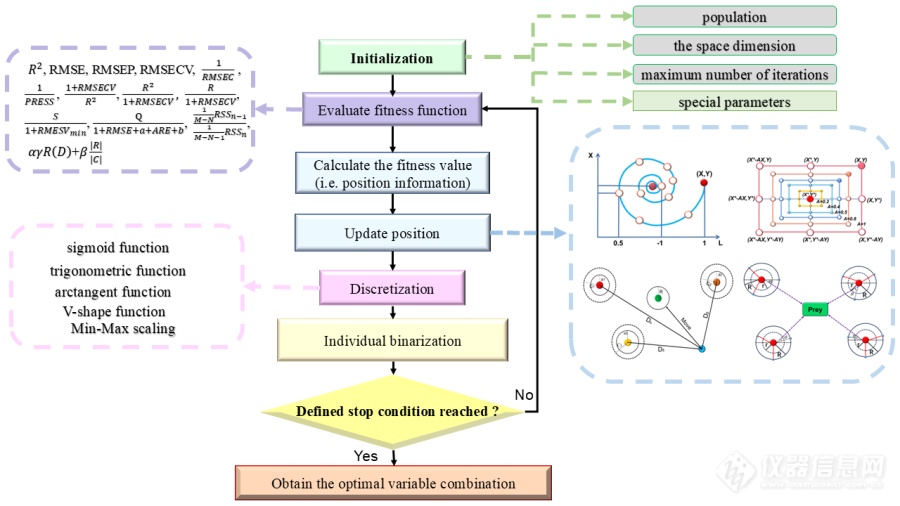
图5 用于光谱变量选择的群体智能优化算法流程图
3.2 不同群体智能优化算法在光谱变量选择中的不同点
3.2.1 适应度函数
变量选择产生的解的质量与群体智能优化算法的可搜索性和适应度函数有关,适应度函数可以引导算法在整个搜索空间中到达期望的区域[137]。因此,建立良好的适应度函数可以加快收敛速度,提高计算精度。在进行光谱变量选择后,建立了不同的模型。因此,模型的不同评价指标被用作群体智能算法的适应度函数。总结所有相关文献,共有13种适应度函数被用于光谱变量选择。校正集预测值与测量值之间相关系数的平方被用作评价每个搜索个体所选变量质量的标准[138]。对应模型拟合得越好,其适应度越高。均方根误差(Root Mean Squared Error,RMSE)[139]、预测均方根误差(Root Mean Squared of Prediction,RMSEP)[140]和交叉验证均方根误差(Root Mean Squared Error of Cross-Validation,RMSECV)[141]也被用作适应度函数。它们的值越小,对应模型的预测能力就越好。当用校正均方根(Root Mean Squared Error of Calibration,RMSEC)和预测平方和(Predicted Sum of Squares,PRESS)的倒数作为适应度函数时[142,143],它们的值越高,模型的预测能力就越强。除上述函数外,还有以下7个由不同评价指标和其他参数组合而成的函数可用作适应度函数[144-150]:




其中Rc为校正相关系数。

其中S为重要因素。RMSEVmin为验证均方根误差(RMSEV)的最小值。


其中ARE是平均相对误差。RMSE和ARE越小,相应模型的预测能力越强,Q是一个常数,用来调整适应度函数的收敛有效性。

这里M是因变量的个数。N是从每一代中提取的变量数。RSSn是第n代模型的残差平方和。当F小于或等于1时,即新提取的潜在变量不能明显减小模型误差时,该潜在变量将被舍弃,从M变量模型中提取潜在变量的过程将停止。

其中 为给定预测器相对于变量选择决策的预测错误率,R为所选变量子集的长度,C为数据集中变量的总数,
为给定预测器相对于变量选择决策的预测错误率,R为所选变量子集的长度,C为数据集中变量的总数,
 和
和
 分别对应于预测质量和子集长度的重要性,
分别对应于预测质量和子集长度的重要性, 。
。
3.2.2 位置更新
群体智能算法表现出两种明确的行为,即探索和开发,并通过个体的位置更新来实现[151]。在探索阶段,利用随机算子对变量空间进行任意的、全局的探索,在广阔的变量空间中寻找更好的解。经过充分的探索,解决方案开始合理地改变,并在搜索空间中最令人鼓舞的解决方案中进行局部处理,从而有可能提高其解决方案的质量。在开发阶段,其主要目的是改善探索过程中获得的最佳解决方案的性能。虽然所有的群体智能算法都是通过探索和利用找到全局最优,但不同的算法模拟不同的生物种群机制。
算法的第一种机制是初始种群根据相同的位置更新方程一起更新它们的位置。如图6(a)所示,粒子群优化(PSO)中的所有个体以相同的方式一起更新位置。第二种算法机制模拟生物种群的繁殖行为,社会种群可分为雄性和雌性群体,如蜉蝣算法(MA)。MA的流程如图6(b)所示,两个种群用不同的方法更新位置,在交配产生后代后,新种群共同参与优化搜索。第三种机制涉及种群的多种行为,对应于多种位置更新方法的产生。如蛇优化(Snake Optimization,SO)算法,将蛇群分为雌性和雄性,模拟蛇的搏斗和交配模式,以实现全局优化。图6(c)显示了蛇优化算法的流程。第四种机制最为复杂,将整个种群划分为多个亚群,每个亚群又有不同的机制,以模拟更复杂的社会组织。野马优化算法(Wild Horse Optimizer,WHO)属于这一类算法,其流程如图6(d)所示。马种群分为多个组,每个组内有一个种马和多个小马驹。每个组模拟不同的行为,并且种马和小马驹执行不同的位置更新方法。虽然更新机制基本上分为上述四大类,但是属于同一类更新机制的不同算法也有不同的位置更新公式,从而构成了各种算法。例如,在鲸鱼优化算法(WOA)中,座头鲸在一个不断缩小的圆圈内围绕猎物游动,并同时沿着螺旋形路径游动。为了模拟这种同步行为,提出了收缩包围机制和更新鲸鱼位置的螺旋模型,如图7(a)和图7(b)所示。灰狼优化算法(Grey Wolf Optimizer,GWO)根据狼群的适应度选择α、β和δ型狼。如图7(c)所示,α、β和δ狼估计猎物的位置,其他狼则围绕猎物随机更新自己的位置。在沙猫群优化算法(SCSO)中,沙猫的灵敏度范围被假定为一个圆,这样,移动方向就由圆上的随机角度()决定。在指定运动方向时,其他参数也会产生影响。在指定运动方向时,其他参数也会产生影响。由于选择的随机角度介于0和360之间,种群中的每个成员都能在搜索空间的不同圆周方向上移动。通过这种方式,沙猫可以接近狩猎位置。随机角度也用于避免局部最优陷阱。SCSO中的位置更新如图7(d)所示。这些算法的不同位置更新策略可以在它们的代码中显示出来。
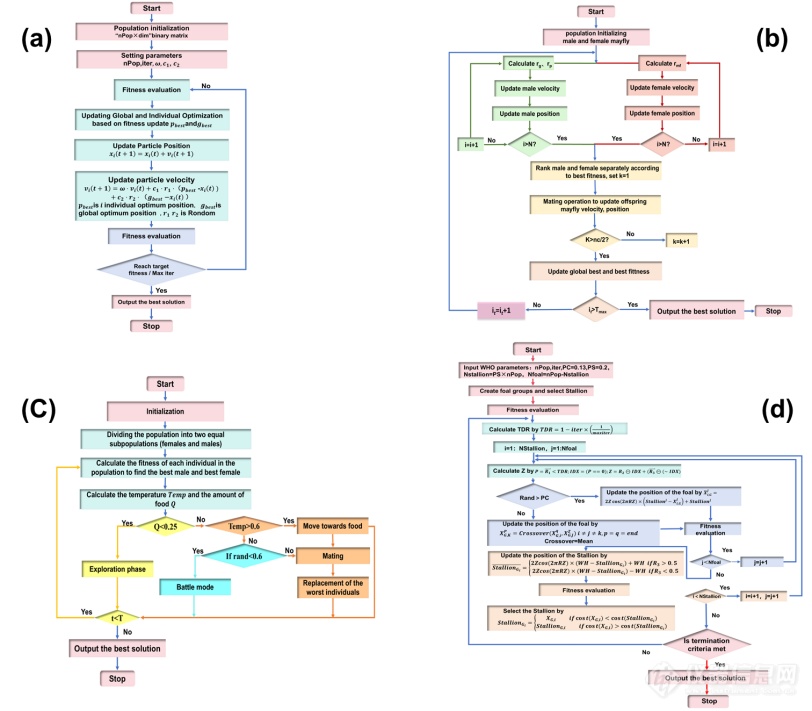
图6 群体智能优化算法的不同机制;(a)PSO流程图;(b)MA流程图;(c)SO流程图;(d)WHO流程图

图7 不同的位置更新;(a)WOA中的收缩包围机制;(b)WOA中的螺旋更新位置;(c)GWO中的位置更新;(d)SCSO中的位置更新
3.2.3 离散化函数
光谱变量选择过程可以表述为一个二进制优化问题。在二进制空间中,个体的位置更新意味着在“0”和“1”值之间切换。连续型的群体智能算法不能直接应用于二进制问题。主要问题在于如何将现实世界中速度的概念转换为二进制空间。
将连续群体智能算法转换为二进制算法有不同的方法,最常用的是传递函数。图8显示了用于群体智能算法离散化的五个传递函数。Kennedy和Eberhart在二进制PSO中首次提出将Sigmoid函数作为传递函数[152]。该传递函数为:

PSO[153]、FA[154]、WOA[155]、HHO[156]等均采用正切双曲函数作为传递函数。正切双曲函数为:

arctan函数也被用作群体智能算法离散化的传递函数[157]。正切双曲函数为:

除上述函数外,Mirjalili还根据这些传递函数的形状将其分为S形和V形传递函数,并提出了两种不同的V形传递函数,具体为[153]:


除了传递函数外,最小-最大缩放也可以将个体的位置向量映射到[0,1]。离散方法为:


其中为x单个位置,ub和lb表示搜索空间的上界和下界,分别为ub>0和lb<0。yij是个体位置的二进制结果。
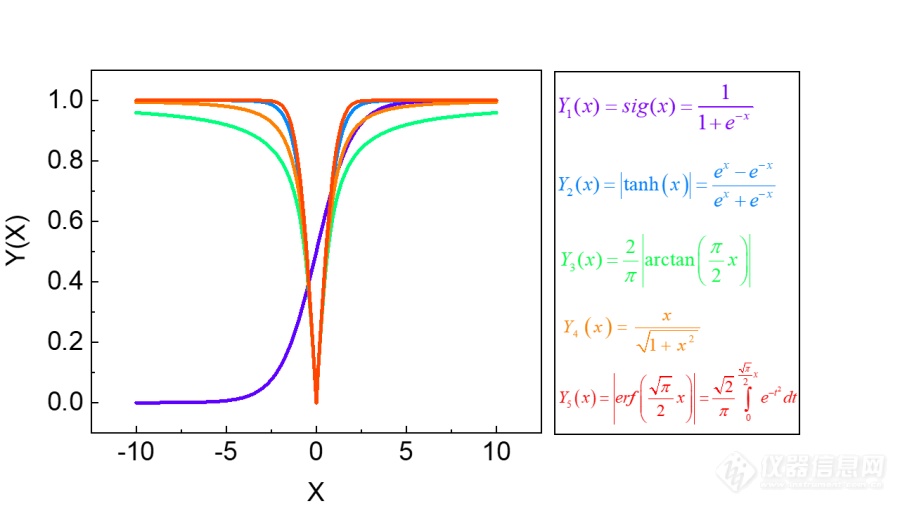
图8 用于变量选择的不同离散化函数
4. 挑战和未来展望
虽然目前的群体智能优化算法已经证明了它们在优化问题中能够可靠地发现全局最优解,但值得注意的是,并非所有的群体智能优化算法都能有效地找到所有类型问题的全局最优解。没有免费的午餐(no-free-lunch,NFL)理论[158]明确说明了这一点,该理论认为,不存在也永远不会存在能够有效解决各种优化问题的算法。因此,这一理论鼓励研究人员提出新的和更有效的群体智能优化算法。此外,大多数算法都有多个控制参数,很难选择一组最佳参数来适应不同的问题。在此,我们提出了发展新的光谱变量选择方法的建议。
1.发展现有的算法并提出新的算法。目前已提出了数百种群体智能优化算法,但只有22种用于光谱变量选择。目前还没有专门针对光谱变量选择提出二进制群体智能算法。因此,探索和发展光谱变量选择的群体智能优化算法也可能是未来研究的重点。
2.混合方法。现有的群体智能优化算法众多,每一种算法都有其独特的优点和特点。我们要抓住这些特点,把它们有效地结合起来。实际上,人们已经提出了一些混合方法来结合上述不同的特性,并取得了良好的效果。
3.多目标优化。当前的变量选择方法严重依赖于单个适应度函数来寻找最佳变量子集。多目标优化是指同时对多个目标函数进行优化的数学优化问题。在光谱变量选择中,适应度函数不局限于RMSEC或R;它还可以包括变量数量和PLS的因子数。通过选择多个适应度函数并行优化,所选变量构建的模型具有较好的预测能力和可解释性。
5. 结论
群体智能优化算法通过模拟自然界中群居生物的社会行为,已成为解决复杂优化问题的重要工具,近年来在跨学科研究领域逐渐流行起来。本综述全面考察了102种群体智能优化算法,并根据生物学原理对群体智能优化算法进行了分类,然后整理了应用于光谱变量选择的群体智能优化算法。在光谱变量选择领域,群体智能优化算法显示出巨大的潜力。为了帮助读者更好地理解和正确应用,本文介绍了群体智能算法在变量选择过程中的异同,以帮助研究人员在变量选择中使用它们。
最后,从更深层次的角度提出了光谱变量选择中群体智能算法的发展趋势。鼓励研究人员开发新的高效方法来解决现有的变量选择问题,这将极大地促进光谱学的发展。
参考文献
[1] J. Song, X. Shi, H. Wang, X. Lv, W. Zhang, J. Wang, T. Li, W. Li. Combination of feature selection and geographical stratification increases the soil total nitrogen estimation accuracy based on vis-NIR and pXRF spectral fusion. Comput. Electron. Agric. 218 (2024) 108636. https://doi.org/10.1016/j.compag.2024.108636.
[2] H. Yu, L. Qing, D. Yan, G. Xia, C. Zhang, Y. Yun, W. Zhang. Hyperspectral imaging in combination with data fusion for rapid evaluation of tilapia fillet freshness. Food Chem. 348 (2021) 129129.https://doi.org/10.1016/j.foodchem.2021.129129.
[3] N.S. Katamesh, A.E.F. Abbas, S.A. Mahmoud. Four chemometric models enhanced by Latin hypercube sampling design for quantification of anti-COVID drugs: sustainability profiling through multiple greenness, carbon footprint, blueness, and whiteness metrics. BMC Chem. 18 (2024 54. https://doi.org/10.1186/s13065-024-01158-7.
[4] C. Ma, L. Zhai, J. Ding, Y. Liu, S. Hu, T. Zhang, H. Tang, H. Li. Raman spectroscopy combined with partial least squares (PLS) based on hybrid spectral preprocessing and backward interval PLS (biPLS) for quantitative analysis of four PAHs in oil sludge. Spectrochimica Acta Part A-Molecular and Biomolecular Spectroscopy. Spectrochim Acta A Mol. Biomol. Spectrosc. 310 (2024) 123953. https://doi.org/10.1016/j.saa.2024.123953.
[5] H. Chen, Y. Han, Y. Liu, D. Liu, L. Jiang, K. Huang, H. Wang, L. Guo, X. Wang, J. Wang, W. Xue. Classification models for Tobacco Mosaic Virus and Potato Virus Y using hyperspectral and machine learning techniques. Front Plant Sci. 14 (2023) 1211617. https://doi.org/10.3389/fpls.2023.1211617.
[6] J. Liu, F. Ma, T. Chen, D. Jiang, M. Du, X. Zhang, X. Feng, Q. Wang, J. Cao, J. Wang. High-time resolution PM2.5 source apportionment assisted by spectrum-based characteristics analysis. Sci. Total Environ. 912 (2024) 169055. https://doi.org/10.1016/j.scitotenv.2023.169055.
[7] Y. Yun, H. Li, B. Deng, D. Cao. An overview of variable selection methods in multivariate analysis of near-infrared spectra. Trac-Trend Anal Chem. 113 (2019) 102-115. https://doi.org/10.1016/j.trac.2019.01.018.
[8] M.C.U. Araújo, T.C.B. Saldanha, R.K.H. Galvao, T. Yoneyama, H.C. Chame, V. Visani. The successive projections algorithm for variable selection in spectroscopic multicomponent analysis. Chemometr. Intell. Lab. Syst. 57 (2001) 65. https://doi.org/10.1016/S0169-7439(01)00119-8.
[9] S. Favilla, C. Durante, M.L. Vigni, M. Cocchi. Assessing feature relevance in NPLS models by VIP. Chemom. Intell. Lab. Syst. 129 (2013) 76-86. https://doi.org/10.1016/j.chemolab.2013.05.013.
[10] D. Wu, P. Nie, Y. He, Z. Wang, H. Wu. Spectral Multivariable Selection and Calibration in Visible-Shortwave Near-Infrared Spectroscopy for Non-Destructive Protein Assessment of Spirulina Microalga Powder. Int. J. Food Prop. 16 (2013) 1002-1015. https://doi.org/10.1080/10942912.2011.574328.
[11] W. Cai, Y. Li, X. Shao. A variable selection method based on uninformative variable elimination for multivariate calibration of near-infrared spectra. Chemom. Intell. Lab. Syst. 90 (2008) 188-194. https://doi.org/10.1016/j.chemolab.2007.10.001.
[12] H. Xu, Z. Liu, W. Cai, X. Shao. A wavelength selection method based on randomization test for near-infrared spectral analysis. Chemometr. Intell. Lab. Syst. 97 (2009) 189. https://doi.org/10.1016/j.chemolab.2009.04.006.
[13] H. Li, Y. Liang, Q. Xu, D. Cao. Key wavelengths screening using competitive adaptive reweighted sampling method for multivariate calibration. Analytica Chimica Acta. 648 (2009) 77-84. https://doi.org/10.1016/j.aca.2009.06.046.
[14] Y. Yun, W. Wang, M. Tan, Y. Liang, H. Li, D. Cao, H. Lu, Q. Xu. A strategy that iteratively retains informative variables for selecting optimal variable subset in multivariate calibration. Analytica Chimica Acta. 807 (2014) 36-43. https://doi.org/10.1016/j.aca.2013.11.032.
[15] R. Leardi. Genetic algorithms in chemometrics and chemistry: a review, J. Chemometr. 15 (2001) 559. https://doi.org/10.1002/cem.651.
[16] K. Ren, X. Wang, X. Shi, J. Qu, W. Fang. Examination and comparison of binary metaheuristic wrapper-based input variable selection for local and global climate information-driven one-step monthly streamflow forecasting. J. Hydrol. 597 (2021) 126152. https://doi.org/10.1016/j.jhydrol.2021.126152.
[17] M. Ehsani, P. Hamidian, P. Hajikarimi, Pouria; F.M. Nejad. Optimized prediction models for faulting failure of Jointed Plain concrete pavement using the metaheuristic optimization algorithms. Constr. Build. Mater. 364 (2023) 129948. https://doi.org/10.1016/j.conbuildmat.2022.129948.
[18] B.D. Kwakye, Y. Li, H.H. Mohamed, E. Baidoo, T.Q. Asenso. Particle guided metaheuristic algorithm for global optimization and feature selection problems. Expert Syst. Appl. 248 (2024) 123362. https://doi.org/10.1016/j.eswa.2024.123362.
[19] S.M. Almufti, A.A. Shaban, Z.A. Ali, R.I. Ali, J.A. Dela Fuente. Overview of Metaheuristic Algorithms. Polaris Global Journal of Scholarly Research and Trends. 2 (2023) 10-32. https://doi.org/10.58429/pgjsrt.v2n2a144.
[20] A.A. Heidari, M. Asghar, H. Faris, I. Aljarah, M. Aljarah, H. Chen. Harris hawks optimization: Algorithm and applications. Future Gener Comput Syst. 97 (2019) 849-872. https://doi.org/10.1016/j.future.2019.02.028.
[21] C. Zhong, G. Li, Z. Meng. Beluga whale optimization: A novel nature-inspired metaheuristic algorithm. Knowl Based Syst. 251 (2022) 109215. https://doi.org/10.1016/j.knosys.2022.109215.
[22] F.A. Hashim, A.G. Hussien. Snake Optimizer: A novel meta-heuristic optimization algorithm. Knowl Based Syst. 242 (2022) 108320. https://doi.org/10.1016/j.knosys.2022.108320.
[23] M Braik, A Hammouri, J Atwan, M A Al-Betar, M. A. Awadallah. White Shark Optimizer: A novel bio-inspired meta-heuristic algorithm for global optimization problems. Knowl Based Syst. 243 (2022) 108457. https://doi.org/10.1016/j.knosys.2022.108457.
[24] L. Brezocnik, I. Fister Jr, V. Podgorelec. Swarm Intelligence Algorithms for Feature Selection: A Review. Appl. Sci.-Basel. 8 (2018) 1521. https://doi.org/10.3390/app8091521.
[25] H. Ma, S. Ye, D. Simon, M. Fei. Conceptual and numerical comparisons of swarm intelligence optimization algorithms, Soft Comput. 21 (2017) 3081-3100. https://doi.org/10.1007/s00500-015-1993-x.
[26] M. Braik, A. Sheta, H. Al-Hiary. A novel meta-heuristic search algorithm for solving optimization problems: capuchin search algorithm, Neural Comput. Appl. 33 (2020) 2515-2547. https://doi.org/10.1007/s00521-020-05145-6.
[27] B. Yu, C. Yan, J. Yuan, N. Ding, Z. Chen. Prediction of soil properties based on characteristic wavelengths with optimal spectral resolution by using Vis-NIR spectroscopy. Spectrochim Acta A Mol. Biomol. Spectrosc. 293 (2023) 122452. https://doi.org/10.1016/j.saa.2023.122452.
[28] W. Liu, J. Wang, L. Chen, B. Chen. Prediction of protein essentiality by the improved particle swarm optimization. Soft Comput. 22 (2017) 6657-6669. https://doi.org/10.1007/s00500-017-2964-1.
[29] K.S. Smirnov, S. Forcisi, F. Moritz, M. Lucio, P. Schmitt-Kopplin. Mass Difference Maps and Their Application for the Recalibration of Mass Spectrometric Data in Nontargeted Metabolomics. Anal. Chem. 91 (2019) 3350-3358. https://doi.org/10.1021/acs.analchem.8b04555.
[30] P. Zuvela, J. Liu, K. Macur, T. Baczek. Molecular Descriptor Subset Selection in Theoretical Peptide Quantitative Structure-Retention Relationship Model Development Using Nature-Inspired Optimization Algorithms. Anal. Chem. 87 (2015) 9876-9883. https://doi.org/10.1021/acs.analchem.5b02349.
[31] E. Mohamed B, H.M. Zawbaa, A. Serag. An evaluation of different bio-inspired feature selection techniques on multivariate calibration models in spectroscopy. Spectrochim Acta A Mol. Biomol. Spectrosc. 246 (2020) 119042. https://doi.org/10.1016/j.saa.2020.119042.
[32] J. Wang, B. Yang, Y. Chen, K. Zeng, H. Zhang, H. Shu, Y. Chen. Novel phasianidae inspired peafowl (Pavo muticus/cristatus) optimization algorithm: Design, evaluation, and SOFC models parameter estimation. Sustain Energy Techn and Assess. 50 (2022) 101825. https://doi.org/10.1016/j.seta.2021.101825.
[33] Y. Zhong, A. Ma, Y. Ong, Z. Zhu, L. Zhang. Computational intelligence in optical remote sensing image processing. Appl. Soft Comput. 64 (2018) 75-93. https://doi.org/10.1016/j.asoc.2017.11.045.
[34] X. Zou, J. Zhao, M.J.W. Povey, M. Holmes, H. Mao. Variables selection methods in near-infrared spectroscopy. Anal. Chim. Acta. 667 (2010) 14-32. https://doi.org/10.1016/j.aca.2010.03.048.
[35] M. Goodarzi, S. Sharma, H. Ramon, W. Saeys. Multivariate calibration of NIR spectroscopic sensors for continuous glucose monitoring. Trac-Trend Anal Chem. 67 (2015) 147-158. https://doi.org/10.1016/j.trac.2014.12.005.
[36] M. Mavrovouniotis, C. Li, S. Yang. A survey of swarm intelligence for dynamic optimization: Algorithms and applications. Swarm Evol. Comput. 33 (2017) 1-17.
[37] M. Dorigo, Vittorio. Maniezzo, A. Colorni, Ant system: optimization by a colony of cooperating agents. IEEE Trans. Syst. Man Cybern. Syst. 26 (1996) 29-41. https://doi.org/10.1109/3477.484436.
[38] R. Eberhart, J. Kennedy. A new optimizer using particle swarm theory. MHS'95. Proceedings of the Sixth International Symposium on Micro Machine and Human Science. 1995, 39-43. https://doi.org/10.1109/MHS.1995.494215.
[39] L. Xiao, Z. Shao, J. Qian. An Optimizing Method Based on Autonomous Animats: Fish-swarm Algorithm. Systems Engineering-theory & Practice. 22 (2002) 32-38. https://doi.org/10.12011/1000-6788(2002)11-32.
[40] K.M. Passino, Biomimicry of bacterial foraging for distributed optimization and control. IEEE Control Syst. 22 (2002) 52-67. https://doi.org/10.1109/MCS.2002.1004010.
[41] M.M. Eusuff, K.E. Lansey. Optimization of Water Distribution Network Design Using the Shuffled Frog Leaping Algorithm. J. Water Resour. 129 (2003) 210-225. https://doi.org/10.1061/(ASCE)0733-9496(2003)129:3(210).
[42] D. Karaboga, B. Basturk. A powerful and efficient algorithm for numerical function optimization: artificial bee colony (ABC) algorithm. J Glob Optim. 39 (2007) 459-471. https://doi.org/10.1007/s10898-007-9149-x.
[43] S. Chu, P. Tsai, J. Pan. Cat Swarm Optimization. 9th Pacific Rim International Conference on Artificial Intelligence. 4099 (2006) 854-858. https://doi.org/10.1007/978-3-540-36668-3_94.
[44] A.R. Mehrabian, C. Lucas. A novel numerical optimization algorithm inspired from weed colonization. Ecol Inform. 1 (2006) 355-366. https://doi.org/10.1016/j.ecoinf.2006.07.003.
[45] R. Zhao, W. Tang. Monkey Algorithm for Global Numerical Optimization. J. Uncertain Syst 2 (2008) 165-176.
[46] X. Yang, S. Deb. Cuckoo search via levey flights. 2009 World Congress on Nature & Biologicall Inspired Computing, (2009) 210-214. https://doi.org/10.1109/NABIC.2009.5393690.
[47] X. Yang. Firefly Algorithms for Multimodal Optimization. In: O. Watanabe, T. Zeugmann (Eds) Stochastic Algorithms: Foundations and Applications. SAGA 2009. Lecture Notes in Computer Science, vol 5792. Springer, Berlin, Heidelberg. https://doi.org/10.1007/978-3-642-04944-6_14.
[48] X. Yang. A New Metaheuristic Bat-Inspired Algorithm. In: J.R. González, D.A. Pelta, C. Cruz, G.Terrazas, N. Krasnogor (Eds) Nature Inspired Cooperative Strategies for Optimization (NICSO 2010). Studies in Computational Intelligence, vol 284. Springer, Berlin, Heidelberg. https://doi.org/10.1007/978-3-642-12538-6_6.
[49] Z. Chen, H. Tang. Cockroach swarm optimization. International Conference on Computer Engineering and Technology. (2010). https://doi.org/10.1109/ICCET.2010.5485993.
[50] W. Pan. A new Fruit Fly Optimization Algorithm: Taking the financial distress model as an example. Knowl Based Syst. 26 (2012) 69-74. https://doi.org/10.1016/j.knosys.2011.07.001.
[51] X. Yang. Flower Pollination Algorithm for Global Optimization. In: J. Durand-Lose, N. Jonoska (Eds) Unconventional Computation and Natural Computation. UCNC 2012. Lecture Notes in Computer Science, vol 7445. Springer, Berlin, Heidelberg. https://doi.org/10.1007/978-3-642-32894-7_27.
[52] A.H. Gandomi, A.H. Alavi. Krill herd: A new bio-inspired optimization algorithm. Commun Nonlinear Sci Numer Simul 17 (2012) 4831-4845. https://doi.org/10.1016/j.cnsns.2012.05.010.
[53] E. Cuevas, M. Cienfuegos, D. Zaldívar, M. Pérez-Cisneros. A swarm optimization algorithm inspired in the behavior of the social-spider. Expert Syst. Appl, 40 (2013) 6374-6384. https://doi.org/10.1016/j.eswa.2013.05.041.
[54] X. Li, J. Zhang, M. Yin. Animal migration optimization: an optimization algorithm inspired by animal migration behavior. Neural. Comput. Appl. 24 (2014) 1867-1877. https://doi.org/10.1007/s00521-013-1433-8.
[55] X. Meng, Y. Liu, X. Gao, H. Zhang. A New Bio-inspired Algorithm: Chicken Swarm Optimization. In: Y. Tan, Y. Shi, C.A.C. Coello (Eds) Advances in Swarm Intelligence. ICSI 2014. Lecture Notes in Computer Science, vol 8794. Springer, Cham. https://doi.org/10.1007/978-3-319-11857-4_10.
[56] Z. He, N. Li, W. Li. Cicada Sing Optimization: A New Evolutionary Algorithm Based on Bionics. Comput. Sci. 41 (2014) 235-238. https://doi.org/10.11896/j.issn.1002-137X.2014.06.046.
[57] S. Mirjalili, S. Mohammad Mirjalili, A. Lewis. Grey Wolf Optimizer. Adv. Eng. Softw. 69 (2014) 46-61. https://doi.org/10.1016/j.advengsoft.2013.12.007.
[58] H. Duan, P. Qiao. Pigeon-inspired optimization : a new swarm intelligence optimizer for air robot path planning. Int. J. Intell. 7 (2014) 24-37. https://doi.org/10.1108/IJICC-02-2014-0005.
[59] J.C. Bansal, H. Sharma, S.S. Jadon, M. Clerc. Spider Monkey Optimization algorithm for numerical optimization. Memet Comput. 6 (2014) 31-47. https://doi.org/10.1007/s12293-013-0128-0.
[60] M. Cheng, D. Prayogo. Symbiotic organisms search: a new metaheuristic optimization algorithm. Comput & Struct. 139 (2014) 98-112. https://doi.org/10.1016/j.compstruc.2014.03.007.
[61] S. Mirjalili, The Ant Lion Optimizer, Adv Eng Softw. 83 (2015), 80-98. https://doi.org/10.1016/j.advengsoft.2015.01.010.
[62] X. Meng, X. Gao, L. Lu, Y. Liu, H. Zhang. A new bio-inspired optimization algorithm: Bird Swarm Algorithm. J Exp Theor Artif Intell. 28 (2016) 673-687. https://doi.org/10.1080/0952813X.2015.1042530.
[63] G. Wang, X. Zhao, S. Deb. A Novel Monarch Butterfly Optimization with Greedy Strategy and Self-adaptive Crossover Operator. 2015 Second International Conference on Soft Computing and Machine Intelligence. (2015) 45-50. https://doi.org/10.1109/ISCMI.2015.19.
[64] S. Mirjalili, Moth-Flame Optimization Algorithm: A Novel Nature-inspired Heuristic Paradigm. Knowl Based Syst. 89 (2015) 228-249. https://doi.org/10.1016/j.knosys.2015.07.006.
[65] M.S. Kiran. TSA: Tree-seed algorithm for continuous optimization. Expert Syst. App. 42 (2015) 6686-6698. https://doi.org/10.1016/j.eswa.2015.04.055.
[66] A. Askarzadeh. A novel metaheuristic method for solving constrained engineering optimization problems: crow search algorithm. Comput & Struct. 169 (2016) 1-12. https://doi.org/10.1016/j.compstruc.2016.03.001.
[67] S. Mirjalili. Dragonfly algorithm: a new meta-heuristic optimization technique for solving single-objective, discrete, and multi-objective problems. Neural. Comput. Appl. 27 (2016) 1054-1073. https://doi.org/10.1007/s00521-015-1920-1.
[68] G. Wang, S. Deb, X. Gao, L.D.S. Coelho. A new metaheuristic optimisation algorithm motivated by elephant herding behaviour. Int J Bio-Inspir Com. 8 (2017) 394-409. https://doi.org/10.1504/IJBIC.2016.081335.
[69] A.A.A. Mohamed,Y.S. Mohamed, A.A.M. El-Gaafary, A. M. Hemeida. Optimal power flow using moth swarm algorithm. Electr. Power Syst. Res. 142 (2017) 190-206. https://doi.org/10.1016/j.epsr.2016.09.025.
[70] S. Mirjalili, A. Lewis. The whale optimization algorithm. Adv. Eng. Softw. 95 (2016) 51-67. https://doi.org/10.1016/j.advengsoft.2016.01.008.
[71] X. Jiang, S. Li. BAS: Beetle Antennae Search Algorithm for Optimization Problems. International Journal of Robotics and Control. 1 (2017). https://doi.org/arxiv-1710.10724.
[72] S. Saremi, S. Mirjalili, A. Lewis. Grasshopper Optimization Algorithm: Theory and application. Adv. Eng. Softw. 105 (2017) 30-47. https://doi.org/10.1016/j.advengsoft.2017.01.004.
[73] S.H.S. Moosavi, V.K. Bardsiri. Satin bowerbird optimizer: A new optimization algorithm to optimize ANFIS for software development effort estimation. Eng Appl Artif Intell. 60 (2017) 1-15. https://doi.org/10.1016/j.engappai.2017.01.006.
[74] F. Fausto, E. Cuevas, A. Valdivia, A. Gonzalez. A global optimization algorithm inspired in the behavior of selfish herds. Biosystems. 160 (2017) 39-55. https://doi.org/10.1016/j.biosystems.2017.07.010.
[75] G. Dhiman, V.A. Kumar. Spotted hyena optimizer: A novel bio-inspired based metaheuristic technique for engineering applications. Adv. Eng. Softw. 114 (2017) 48-70. https://doi.org/10.1016/j.advengsoft.2017.05.014.
[76] S. Mirjalili, A. H. Gandomi, S.Z. Mirjalili, S. Saremi, H. Faris, S.M. Mirjalili. Salp Swarm Algorithm: A bio-inspired optimizer for engineering design problems. Adv. Eng. Softw. 114 (2017) 163-191. https://doi.org/10.1016/j.advengsoft.2017.07.002.
[77] J. Pierezan, L.D.S. Coelho. Coyote optimization algorithm: A new metaheuristic for global optimization problems. 2018 IEEE Congress on Evolutionary Computation. (2018) 1-8. https://doi.org/10.1109/CEC.2018.8477769.
[78] A. Khan, S. Senior, P.S. Stanimirovic, Y. Zhang. Model-Free Optimization Using Eagle Perching Optimizer. Neural and Evol Comput. (2018) . https://doi.org/arxiv-1807.02754.
[79] S. Liu, Y. Yang, Y. Zhou. A Swarm Intelligence Algorithm-Lion Swarm Optimization. Intern J Pattern Recognit Artif Intell. 31 (2018) 431-441. https://doi.org/10.16451/j.cnki.issn1003-6059.201805005.
[80] M. Jain, V. Singh, A. Rani. A novel nature-inspired algorithm for optimization: Squirrel search algorithm. Swarm Evol. 44 (2018) 148-175. https://doi.org/10.1016/j.swevo.2018.02.013.
[81] D. Zaldivar, B. Morales, A. Rodriguez, A. Valdivia-G, E. Cuevas, M. Perez-Cisneros. A novel bio-inspired optimization model based on Yellow Saddle Goatfish behavior. Biosystems. 174 (2018) 1-21. https://doi.org/10.1016/j.biosystems.2018.09.007.
[82] S. Arora, S. Singh. Butterfly optimization algorithm: a novel approach for global optimization. Soft Computing. 23 (2019) 715-734. https://doi.org/10.1007/s00500-018-3102-4.
[83] W. Zhao, Z. Zhang, L. Wang. Manta ray foraging optimization (MRFO): An effective bio-inspired optimizer for engineering applications. Eng Appl Artif Intell. 87 (2020) 103-300. https://doi.org/10.1016/j.engappai.2019.103300.
[84] The Sailfish Optimizer: A novel nature-inspired metaheuristic algorithm for solving constrained engineering optimization problems
[85] S. Shadravan, H.R. Naji, V.K. Bardsiri. The Sailfish Optimizer: A novel nature-inspired metaheuristic algorithm for solving constrained engineering optimization problems. Eng Appl Artif Intell. 80 (2019) 20-34. https://doi.org/10.1016/j.engappai.2019.01.001.
[86] G. Dhiman, V. Kumar. Vijay. Seagull optimization algorithm: Theory and its applications for large-scale industrial engineering problems. Knowl Based Syst. 165 (2019) 169-196. https://doi.org/10.1016/j.knosys.2018.11.024.
[87] G. Dhiman, A. Kaur. STOA: A bio-inspired based optimization algorithm for industrial engineering problems. Eng Appl Artif Intell. 82 (2019) 148–174. https://doi.org/10.1016/j.engappai.2019.03.021.
[88] T. Dutta, S. Bhattacharyya, S. Dey, J. Platos. Border Collie Optimization. IEEE Access. 8 (2020) 109177-109197. https://doi.org/10.1109/access.2020.2999540.
[89] H.A. MAlsattar, A.A. Zaidan, B.B. Zaidan. Novel meta-heuristic bald eagle search optimisation algorithm. Artif Intell Rev. 53 (2020) 2237-2264. https://doi.org/10.1007/s10462-019-09732-5.
[90] V. Hayyolalam, A.A.P. Kazem. Black Widow Optimization Algorithm: A novel meta-heuristic approach for solving engineering optimization problems. Eng Appl Artif Intell. 87 (2020) 103249. https://doi.org/10.1016/j.engappai.2019.103249.
[91] M. Khishe, M.R. Mosavi. Chimp optimization algorithm. Expert Syst. Appl. 149 (2020) 113338. https://doi.org/10.1016/j.eswa.2020.113338.
[92] J. Chou, D.N. Truong. A novel metaheuristic optimizer inspired by behavior of jellyfish in ocean. Appl. Math. Comput. 389 (2020) 125-535. https://doi.org/10.1016/j.amc.2020.125535.
[93] K. Zervoudakis, S. Tsafarakis. A mayfly optimization algorithm. Comput Ind Eng. 145 (2020) 1-75. https://doi.org/10.1016/j.cie.2020.106559.
[94] A. Faramarzi, M. Heidarinejad, S. Mirjalili, A. H. Gandomi. Marine Predators Algorithm: A Nature-inspired Metaheuristic. Expert Syst. Appl. 152 (2020) 1-50. https://doi.org/10.1016/j.eswa.2020.113377.
[95] A.A. Mohamed, S. A. Hassan, A.M. Hemeida, S. Alkhalaf, M.M.M. Mahmoud, A. M. Eldin, Baha. Parasitism – Predation algorithm (PPA): A novel approach for feature selection. Ain Shams Engineering Journal. 11 (2020) 293-308. https://doi.org/10.1016/j.asej.2019.10.004.
[96] S. Li, H. Chen, M. Wang, A.A. Heidari, S. Mirjalili. Slime mould algorithm: A new method for stochastic optimization. Future Gener Comput Syst. 111 (2020) 300-323. https://doi.org/10.1016/j.future.2020.03.055.
[97] J. Xue, B. Shen. A novel swarm intelligence optimization approach: sparrow search algorithm. Syst. Sci. Control. Eng.8 (2020) 22-34. https://doi.org/10.1080/21642583.2019.1708830.
[98] S. Kaur, L. K. Awasthi, A. L. Sangal, G Dhiman. Tunicate Swarm Algorithm: A new bio-inspired based metaheuristic paradigm for global optimization. Eng Appl Artif Intell. 90 (2020) 103541. https://doi.org/10.1016/j.engappai.2020.103541.
[99] W. Zhao, L. Wang, S. Mirjalili. Artificial hummingbird algorithm: A new bio-inspired optimizer with its engineering applications. Comput Methods Appl Mech Eng. 388 (2022) 114194. https://doi.org/10.1016/j.cma.2021.114194.
[100] L. Abualigah, D. Yousri, M. Abd Elaziz, A. Ahmed, M.A.A. Alqaness, A. H. Gandomi. Aquila Optimizer: A novel meta-heuristic optimization algorithm. Comput Ind Eng. 157 (2021) 107250. https://doi.org/10.1016/j.cie.2021.107250.
[101] B. Abdollahzadeh, F.S. Gharehchopogh, S. Farhad, S, Mirjalili. African vultures optimization algorithm: A new nature-inspired metaheuristic algorithm for global optimization problems. Comput Ind Eng. 158 (2021) 107408. https://doi.org/10.1016/j.cie.2021.107408.
[102] M. Braik, A. Sheta, H. Al-Hiary. A novel meta-heuristic search algorithm for solving optimization problems: capuchin search algorithm. Neural. Comput. Appl. 33 (2020) 2515-2547. https://doi.org/10.1007/s00521-020-05145-6.
[103] M. S. Braik. Chameleon Swarm Algorithm: A bio-inspired optimizer for solving engineering design problems. Expert Syst. Appl. 174 (2021) 114685. https://doi.org/10.1016/j.eswa.2021.114685.
[104] I. Naruei, F. Keynia. A new optimization method based on COOT bird natural life model. Expert Syst. Appl. 183 (2021) 115352. https://doi.org/10.1016/j.eswa.2021.115352.
[105] O. K. Meng, O. Pauline, S. C. Kiong. A carnivorous plant algorithm for solving global optimization problems. Appl. Soft Comput. 98 (2021) 106833. https://doi.org/10.1016/j.asoc.2020.106833.
[106] H. Peraza-Vazquez, A.F. Pena-Delgado, G. Echavarria-Castillo, A. Beatriz Morales-Cepeda, J. Velasco-Alvarez, F. Ruiz-Perez. A bio-inspired method for engineering design optimization inspired by dingoes hunting strategies. Math. Probl. Eng. (2021) 9107547. https://doi.org/10.1155/2021/9107547.
[107] A. Mohammadi-Balani, M.D. Nayeri, D. Mahmoud, A. Azar, M. Taghizadeh-Yazdi, Golden Eagle Optimizer: A nature-inspired metaheuristic algorithm. Comput Ind Eng. 152 (2021) 107050. https://doi.org/10.1016/j.cie.2020.107050.
[108] B. Abdollahzadeh, F.S. Gharehchopogh, S. Mirjalili. Artificial gorilla troops optimizer: A new nature‐inspired metaheuristic algorithm for global optimization problems. Int. J. Intell. Syst.. 36 (2021) 5887-5958. https://doi.org/10.1002/int.22535.
[109] F. A. Hashim, E.H. Houssein, K. Hussain, M.S. Mabrouk, W. Al-Atabany. Honey Badger Algorithm: New metaheuristic algorithm for solving optimization problems. Math Comput Simul. 19 (2021) 84-110. https://doi.org/10.1016/j.matcom.2021.08.013.
[110] Y. Yang, H. Chen, A. A. Heidari, A. H. Gandomi. Hunger games search: Visions, conception, implementation, deep analysis, perspectives, and towards performance shifts. Expert Syst. Appl. 177 (2021) 114-864. https://doi.org/10.1016/j.eswa.2021.114864.
[111] H. Peraza-Vazquez, A. Pena-Delgado, P. Ranjan, C. Barde, A. Choubey, A. B. Morales-Cepeda. A bio-inspired method for mathematical optimization inspired by arachnida salticidade. mathematics. 10 (2022) 102. https://doi.org/10.3390/math10010102.
[112] H. Jia, X. Peng, C. Lang. Remora optimization algorithm. Expert Syst. Appl.185 (2021) 115665. https://doi.org/10.1016/j.eswa.2021.115665.
[113] L. Abualigah, M. Abd Elaziz, P. Sumari, Z. W. Geem, A. H. Gandomi. Reptile Search Algorithm (RSA): A nature-inspired meta-heuristic optimizer. Expert Syst. Appl. 191 (2021) 116158. https://doi.org/10.1016/j.eswa.2021.116158.
[114] G. Dhiman, M. Garg, A. Nagar, V. Kumar, M. Dehghani. A novel algorithm for global optimization: Rat Swarm Optimizer (RSO). J Ambient Intell Humaniz Comput. 12 (2021) 8457-8482. https://doi.org/10.1007/s12652-020-02580-0.
[115] L. Xie, T. Han, H. Zhou, Z. Zhang, B. Han, A. Tang. Tuna swarm optimization: a novel swarm-based metaheuristic algorithm for global optimization. Computational Intelligence and Neuroscience. 2021 (2021) 1-22. https://doi.org/10.1155/2021/9210050.
[116] I. Naruei, F. Keynia. Wild horse optimizer: A new meta-heuristic algorithm for solving engineering optimization problems. Eng Comput. 38 (2022) 3025-3056. https://doi.org/10.1007/s00366-021-01438-z.
[117] L. Wang, Q. Cao, Z. Zhang, S. Mirjalili, W. Zhao. Artificial rabbits optimization: A new bio-inspired meta-heuristic algorithm for solving engineering optimization problems. Eng Appl Artif Intell. 114 (2022). 105082. https://doi.org/10.1016/j.engappai.2022.105082.
[118] J. Xue, B. Shen. Dung beetle optimizer: a new meta heuristic algorithm for global optimization. J Supercomput. 79 (2022) 7305–7336. https://doi.org/10.1007/s11227-022-04959-6.
[119] J.O. Agushaka, A.E. Ezugwu, L. Abualigah. Dwarf mongoose optimization algorithm. Comput Methods Appl Mech Eng. 391 (2022) 114570. https://doi.org/10.1016/j.cma.2022.114570.
[120] N. Chopra, M.M. Ansari. Golden jackal optimization: A novel nature-inspired optimizer for engineering applications. Expert Syst. Appl. 198 (2022) 116924. https://doi.org/10.1016/j.eswa.2022.116924.
[121] I. Naruei, F. Keynia, A.S. Molahosseini. Hunter–prey optimization: algorithm and applications. Soft Computing. 26 (2022) 1279-1314. https://doi.org/10.1007/s00500-021-06401-0.
[122] A.K. Abasi, S.N. Makhadmeh, M.A. Al-Betar, O.A.Alomari, M.A. Awadallah, Z.A.A. Alyasseri, I.A. Doush, A. Elnagar, E.H. Alkhammash, M. Hadjouni. Lemurs optimizer: A new metaheuristic algorithm for global optimization. Appl. Sci. 12 (2022) 10057. https://doi.org/10.3390/app121910057.
[123] M. Dehghani, S. Hubalovsky, P. Trojovsky. Northern Goshawk Optimization: A New Swarm-Based Algorithm for Solving Optimization Problems. IEEE Access. 9 (2021) 162059-162080. https://doi.org/10.1109/access.2021.3133286.
[124] P. Trojovsky, M. Dehghani. Pelican Optimization Algorithm: A Novel Nature-Inspired Algorithm for Engineering Applications. Sensors. 22 (2022) 855. https://doi.org/10.3390/s22030855.
[125] H. Jia, H. Rao, C. Wen, S. Mirjalili. Crayfish optimization algorithm. Artif Intell Rev. 56 (2023) 1919-1979. https://doi.org/10.1007/s10462-023-10567-4.
[126] H. Mohammed, T. Rashid. FOX: a FOX-inspired optimization algorithm. Appl Intell. 53 (2023) 1030-1050. https://doi.org/10.1007/s10489-022-03533-0.
[127] G. Hu, Y. Guo, G. Wei, L. Abualigah. Genghis Khan shark optimizer: a novel nature-inspired algorithm for engineering optimization. Adv. Eng. Inform. 58 (2023) 102210. https://doi.org/10.1016/j.aei.2023.102210.
[128] M. Abdel-Basset, R. Mohamed, M. Jameel, M. Abouhawwash. Nutcracker optimizer: A novel nature-inspired metaheuristic algorithm for global optimization and engineering design problems. Knowl Based Syst. 262 (2023) 110248. https://doi.org/10.1016/j.knosys.2022.110248.
[129] S. Ferahtia, A. Houari, H. Rezk, A. Djerioui, M. Machmoum, S. Motahhir, M. Ait-Ahmed. Red-tailed hawk algorithm for numerical optimization and real-world problems. Sci. Rep. 13 (2023) 12950. https://doi.org/10.1038/s41598-023-38778-3.
[130] A. Seyyedabbasi, F. Kiani. Sand Cat swarm optimization: a nature-inspired algorithm to solve global optimization problems. Eng Comput. 39 (2023) 2627-2651. https://doi.org/10.1007/s00366-022-01604-x.
[131] V.S.D.M. Sahu, P. Samal, C.K. Panigrahi. Tyrannosaurus optimization algorithm: a new nature-inspired meta-heuristic algorithm for solving optimal control problems. e-Prime- Advances in Electrical Engineering, Electronics and Energy. 5 (2023) 100243. https://doi.org/10.1016/j.prime.2023.100243.
[132] P. Trojovsky, M. Dehghani. A new bio-inspired metaheuristic algorithm for solving optimization problems based on walruses behavior. Sci. Rep. 13 (2023) 8775. https://doi.org/10.1038/s41598-023-35863-5.
[133] L. Zareian, J. Rahebi, M.J. Shayegan. Bitterling fish optimization (BFO) algorithm. Multimed. Tools. Appl. (2024) 1-34. https://doi.org/10.1007/s11042-024-18579-0.
[134] J. Lian, G. Hui, L. Ma, T. Zhu, X. Wu, A. A. Heidari, Y. Chen, H. Chen. Parrot optimizer: Algorithm and applications to medical problems. Comput. Biol. Med. 172 (2024) 108064. https://doi.org/10.1016/j.compbiomed.2024.108064.
[135] S. Sheykhizadeh, A. Naseri. An efficient swarm intelligence approach to feature selection based on invasive weed optimization: Application to multivariate calibration and classification using spectroscopic data. Spectrochim. Acta A Mol. Biomol. Spectrosc. 194 (2018) 202-210. https://doi.org/10.1016/j.saa.2018.01.028.
[136] G. Dhiman, A. Kaur. STOA: a bio-inspired based optimization algorithm for industrial engineering problems. Eng Appl Artif Intell. 82 (2019) 148-174. https://doi.org/10.1016/j.engappai.2019.03.021.
[137] S. Sheykhizadeh, A. Naseri. An efficient swarm intelligence approach to feature selection based on invasive weed optimization: Application to multivariate calibration and classification using spectroscopic data. Spectrochim Acta A Mol. Biomol. Spectrosc. 194 (2018) 202-210. https://doi.org/10.1016/j.saa.2018.01.028.
[138] X. Huang, X. Zou, J. Zhao, J. Shi, X, Zhang, M. Holmes. Measurement of total anthocyanins content in flowering tea using near infrared spectroscopy combined with ant colony optimization models. Food Chem. 164 (2014) 536-543. https://doi.org/10.1016/j.foodchem.2014.05.072.
[139] M. Goodarzi, L.S. Coelho. Firefly as a novel swarm intelligence variable selection method in spectroscopy. Analytica Chimica Acta. 2014 (852) 20-27 https://doi.org/10.1016/j.aca.2014.09.045.
[140] S. Zhao, T. Jiao, Z. Wang, S.Y.S.S. Adade, X. Wu, O. Qin, Q. Chen. On-line detecting soluble sugar, total acids, and bacterial concentration during kombucha fermentation based on the visible/near infrared combined meta-heuristic algorithm J. Food Compos. Anal. 123 (2023) 105653. https://doi.org/10.1016/j.jfca.2023.105653.
[141] X. Bian, Z. Zhao, J. Liu, P. Liu, H. Shi, X. Tan. Discretized butterfly optimization algorithm for variable selection in the rapid determination of cholesterol by near-infrared spectroscopy. Anal. Methods. 15 (2023) 5190-5198. https://doi.org/10.1039/D3AY01636F.
[142] Y. Li, Y. Guo, C. Liu, W. Wang, P. Rao, C. Fu, S. Wang. SPA Combined with Swarm Intelligence Optimization Algorithms for Wavelength Variable Selection to Rapidly Discriminate the Adulteration of Apple Juice. Food. Anal. Methods. 10 (2017) 1965-1971. https://doi.org/10.1007/s12161-016-0772-3.
[143] M. Shamsipur, V. Zare-Shahabadi, B. Hemmateenejad, M. Akhond. Ant colony optimisation: a powerful tool for wavelength selection. J. Chemom. 20 (2006) 146-157. https://doi.org/10.1002/cem.1002.
[144] J. Bin, W. Fan, J. Zhou, X. Li, Y. Liang. Application of Intelligent Optimization Algorithms to Wavelength Selection of Near Infrared Spectroscopy. Spectrosc. Spectral Anal. 37 (2017) 95-102. https://doi.org/10.3964/j.issn.1000-0593(2017)01-0095-08.
[145] W. Chen, Y. Feng, G. Jia, H. Zhao. Application of Artificial Fish Swarm Algorithm for Synchronous Selection of Wavelengths and Spectral Pretreatment Methods in Spectrometric Analysis of Beef Adulteration. Food. Anal. Methods. 11 (2018) 2229-2236. https://doi.org/10.1007/s12161-018-1204-3.
[146] Z. Wang, M. Gao. Selection of Near Infrared Spectral Wavelength Variables Based on Improved Whale Optimization Algorithm and Its Application. J. Instrum. Anal. (2023). 37-44.
[147] J. Cui, M. Yang, D. Son, S. Cho, K. Ghiseo. Hyperspecteal imaging for tomato bruising damage assessment of simulated harvesting process impact using wavelength interval selection and multivariate analysis. Appl. Eng. Agric. 36 (2020) 533-547. https://doi.org/10.13031/aea.13734.
[148] X. Hou, L. Lin, G. Li, J. Chen. Non-destructive and rapid detection of blood quality in blood bags based on modified ACO wavelength selection algorithm. Symposium on Design and Quality for Biomedical Technologies XIII held at SPIE BiOS Conference. 11231 (2020) 61-63. https://doi.org/10.1117/12.2544927.
[149] L. Hu, C. Yin, S. Ma, Z. Liu. Rapid detection of three quality parameters and classification of wine based on Vis-NIR spectroscopy with wavelength selection by ACO and CARS algorithms. Spectrochim. Acta, Part A. 205 (2018) 574-581. https://doi.org/10.1016/j.saa.2018.07.054.
[150] M.B. El-Zeiny, H.M. Zawbaa, A. Serag. An evaluation of different bio-inspired feature selection techniques on multivariate calibration models in spectroscopy. Spectrochim. Acta, Part A. 246 (2021) 119042. https://doi.org/10.1016/j.saa.2020.119042.
[151] E. Alba, B. Dorronsoro. The exploration/exploitation tradeoff in dynamic cellular genetic algorithms. IEEE T. Evolut. Comput. 9 (2005) 126-142. https://doi.org/10.1109/TEVC.2005.843751.
[152] J. Kennedy, R. Eberhart. A discrete binary version of the particle swarm algorithm, 1997 IEEE International Conference on Systems, Man, and Cybernetics. Computational Cybernetics and Simulation, 5 (1997) 4104-4108. https://doi.org/10.1109/ICSMC.1997.637339.
[153] S. Mirjalili, A. Lewis. S-shaped versus V-shaped transfer functions for binary particle swarm optimization. 9 (2013) 1-14. http://dx.doi.org/10.1016/j.swevo.2012.09.002.
[154] Z. Liu, R. Zhang, G. Zhang, K Chen. Wavelength Variable Selection Method in Near Infrared Spectroscopy Based on Discrete Firefly Algorithm, Spectrosc. Spectral Anal. 36 (2016) 3931-3936. https://www.gpxygpfx.com/EN/10.3964/j.issn.1000-0593(2016)12-3931-06.
[155] A.G. Hussien, A.E. Hassanien, E.H. Houssein, M. Amin, A.T. Azar. New binary whale optimization algorithm for discrete optimization problems. Eng. Optimiz. 52 (2020) 945-959. https://doi.org/10.1080/0305215X.2019.1624740.
[156] Y. Wang, Y. Zhou, Q. Luo. Parameter optimization of shared electric vehicle dispatching model using discrete Harris hawks optimization. Math. Biosci. Eng. 19 (2022) 7284-7313. https://doi.org/10.3934/mbe.2022344.
[157] X. Bian, R. Zhang, P. Liu, Y. Xiang, S. Wang, X. Tan. Near infrared spectroscopic variable selection by a novel swarm intelligence algorithm for rapid quantification of high order edible blend oil. Spectrochim. Acta, Part A. 284 (2023) 121788. https://doi.org/10.1016/j.saa.2022.121788.
[158] D.H. Wolpert, W.G. Macready. No free lunch theorems for optimization. IEEE T. Evolut. Comput. 1 (1997) 67-82. https://doi.org/10.1109/4235.585893.
通讯作者简介:
卞希慧,女,1983年生,教授,主要进行化学计量学算法研究及其在中药、食品、环境等方面的应用研究。
E-mail:bianxihui@163.com
第一作者简介
杨文博,男,2001年生,硕士研究生,研究方向为化学计量学算法研究。
E-mail:18822085929@163.com

















 为给定预测器相对于变量选择决策的预测错误率,R为所选变量子集的长度,C为数据集中变量的总数,
为给定预测器相对于变量选择决策的预测错误率,R为所选变量子集的长度,C为数据集中变量的总数,
 和
和
 分别对应于预测质量和子集长度的重要性,
分别对应于预测质量和子集长度的重要性, 。
。








